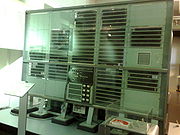
Mailüfterl
Encyclopedia

Austria
Austria , officially the Republic of Austria , is a landlocked country of roughly 8.4 million people in Central Europe. It is bordered by the Czech Republic and Germany to the north, Slovakia and Hungary to the east, Slovenia and Italy to the south, and Switzerland and Liechtenstein to the...
n nickname
Nickname
A nickname is "a usually familiar or humorous but sometimes pointed or cruel name given to a person or place, as a supposedly appropriate replacement for or addition to the proper name.", or a name similar in origin and pronunciation from the original name....
for the first transistorized computer
Computer
A computer is a programmable machine designed to sequentially and automatically carry out a sequence of arithmetic or logical operations. The particular sequence of operations can be changed readily, allowing the computer to solve more than one kind of problem...
on the European mainland. The first computers of this kind were TRADIC
TRADIC
The TRADIC was the first transistorized computer in the USA, completed in 1954....
, Harwell CADET
Harwell CADET
The Harwell CADET was the first fully transistorised computer in Europe, and may have been the first fully transistorised computer in the world....
and TX-0
TX-0
The TX-0, for Transistorized Experimental computer zero, but affectionately referred to as tixo , was an early fully transistorized computer and contained a then-huge 64K of 18-bit words of magnetic core memory. The TX-0 was built in 1955 and went online in 1956 and was used continually through the...
.
It was built in 1955 at the Vienna University of Technology
Vienna University of Technology
Vienna University of Technology is one of the major universities in Vienna, the capital of Austria. Founded in 1815 as the "Imperial-Royal Polytechnic Institute" , it currently has about 26,200 students , 8 faculties and about 4,000 staff members...
by Heinz Zemanek
Heinz Zemanek
Heinz Zemanek is an Austrian computer pioneer who in 1955 developed the first complete transistorised computer on the European continent...
. The builder plays on a quote on an operating (tube
Electron tube
Electron tube can be used to describe either of two things:* Vacuum tube* Gas-filled tube...
) computer: If it is not the rapid calculation speed of American models that whirlwind 'or' Typhoon ' can achieve, it will be enough for a Wiener , Mailüfterl' (which means something like Viennese May breeze).The full name of the is Binär dezimaler Volltransistor-Rechenautomat (binary decimal fully transistored computer).
The computer consists of 3.000 transistor
Transistor
A transistor is a semiconductor device used to amplify and switch electronic signals and power. It is composed of a semiconductor material with at least three terminals for connection to an external circuit. A voltage or current applied to one pair of the transistor's terminals changes the current...
s, 5.000 diode
Diode
In electronics, a diode is a type of two-terminal electronic component with a nonlinear current–voltage characteristic. A semiconductor diode, the most common type today, is a crystalline piece of semiconductor material connected to two electrical terminals...
s, 1.000 assembly platelets, 100.000 solder joints, 15.000 resistor
Resistor
A linear resistor is a linear, passive two-terminal electrical component that implements electrical resistance as a circuit element.The current through a resistor is in direct proportion to the voltage across the resistor's terminals. Thus, the ratio of the voltage applied across a resistor's...
s, 5.000 capacitor
Capacitor
A capacitor is a passive two-terminal electrical component used to store energy in an electric field. The forms of practical capacitors vary widely, but all contain at least two electrical conductors separated by a dielectric ; for example, one common construction consists of metal foils separated...
s and 20,000 meters switching wire. With a width of 4 meters, a height of 2.5 meters and a depth of 50 centimeters, the plant was then compared to the small tube computers.
Zemanek said about his famous project later, it was a half-illegal exercise of a senior student, which he realized without official authorization and hence without financial support from the university with a group of other students. In 1954 he traveled to Philips
Philips
Koninklijke Philips Electronics N.V. , more commonly known as Philips, is a multinational Dutch electronics company....
in Holland, where he asked for a donation in kind
Payment in kind
Payment in kind refers to payment for goods or services with a medium other than legal tender ....
. The amount of 1,000 transistors was very difficult to obtain only seven years after their invention. Yet Zemanek received a commitment for 1000 - rather slow - hearing aid transistors and Philips finally got a total of 4,000 high-quality transistors.
External links
- Oral history interview with Heinz Zemanek, Charles Babbage InstituteCharles Babbage InstituteThe Charles Babbage Institute is a research center at the University of Minnesota specializing in the history of information technology, particularly the history since 1935 of digital computing, programming/software, and computer networking....
, University of Minnesota. Zemanek discusses his engineering education and work in radar technology during World War II. Zemanek then focuses on the development of computers in Austria: magnetic drums and magnetic memory, the MAILUFTERL computer, LOGALGOL and other compilers, the University of Vienna where Zemanek worked on his computer, the subsequent sponsorship of the project by International Business Machines Europe, and ALGOLALGOLALGOL is a family of imperative computer programming languages originally developed in the mid 1950s which greatly influenced many other languages and became the de facto way algorithms were described in textbooks and academic works for almost the next 30 years...
and PL/IPL/IPL/I is a procedural, imperative computer programming language designed for scientific, engineering, business and systems programming applications...
language standards development. - Extensive site on the topic (German)
- Editorial contribution to pressetext.eu (German)
- Mailüfterl emulator in Java

